
Yes, indeed folks. They have been hyping us all up for so many years about flying cars and robots that serve us. The FUTURE was supposed to look something like the Jetsens. But, here we are and flying cars are a reality being developed all across the earth. Robots are here, but not to serve us. In fact it is looking more and more like just the opposite, that we will end up serving them.
They have been feverishly working, they say, to develop new ways to conserve energy and save the planet. The order of the day only recently was Electric Cars. They were trying to force us out of our “gas guzzlers” into the new electric cars. Anyone with any insight could easily see that for a fraud. Our electric grid is already maxed and failing. In California where they were already transitioning to electric cars they found they had to limit the charging times. The batteries require natural elements that are rare and expensive to mine and the batteries themselves are blowing up everywhere. The electric cars have very limited mileage to the charge and can only run at very low speeds, greatly limiting travel capabilities.
So, what is there plan and what is all the hype about? Well, I can assure you they are not interested in making your life more convenient or taking any of the stress off the environment or building back the economy they have managed to destroy.
At any rate, the future is indeed here. It is not the Future you hoped for, but the GOOD NEWS is that it won’t be the FUTURE they have planned either. Maybe for a short time, but the END is near and things are about to take a major change. JUDGEMENT IS COMING and the Earth WILL BE RENEWED!
spacer’
For more information on this topic you might want to visit my earlier posts shown below:
ITS NOT JUST YOUR CAR – ITS YOUR FREEDOM!!
Your Vehicle is about to become EXTINCT!
LOSING OUR RIGHTS RIGHT AND LEFT!
LOSING The Right That Guarantees Your Freedom!
spacer

The following much anticipated all-electric vehicles are on the drawing boards and some are in pre-production. While little is known about these future cars, you can bet that GreenCars will be on hand to serve you the latest dish on them. Once again, we provide them in alphabetical order by automaker. For more information on these vehicles, visit the GreenCars Buyer’s Guide.
Ranges and rates are manufacturer estimates. Actual mileage and charge times may vary.
Audi A6 e-tron
Coming in 2023, the arousing A6 e-tron will be sold alongside its gasoline equivalent brother in showrooms. This four-door luxury sedan will feature cutting-edge tech including incredibly fast charging times. Prices will start in the $80,000 MSRP zone.
Cadillac Celestiq
Following in the tread marks of the forward-thinking Lyriq sedan, the new Celestig is to be a range-topper SUV hatchback for Caddy, but don’t expect to see it until 2025. The automaker says that range will be at lease 300 miles on a charge.
Canoo Pickup Truck
We’ve been waiting to see a production model of this “Lost in Space” pickup from start-up company Canoo for a while. The cab forward trend-setter will be available in rear-wheel or all-wheel drive which is said to deliver 600-horses and 550-pound feet of torque. Driving range will be around 200 miles and Canoo says it will be available sometime in 2023.
Chevrolet Silverado Electric
Not exactly hot on the heels of the best-selling Ford Lightning EV pickup, Chevy will debut the Silverado Electric in late 2023. It will offer four-wheel steering like the Hummer with standard all-wheel drive and up to 664-horsepower. Chevrolet estimates the vehicle’s range to be a whopping 400 miles.
Chevrolet E-Ray?
Though still a product of the rumor mill, there is speculation that Chevy is developing an eighth-generation, 200 miles per hour electric Corvette. However, this “E-Ray” may be a hybrid with two electric motors and a 6.2-liter V8 gas engine. Time will tell.
Dodge e-Muscle
Due to light up American highways in 2024, Dodge is working on an all-electric burnout brute. Little is known about this Challenger-inspired Hellcat, but you can bet it will be crazy fast off the line.
Ford Explorer Electric
The next all-electric Ford may be the Explorer. After all, it is America’s best-selling three-row SUV. It’s all part of making 40 percent of Ford’s lineup EVs by 2030. Expect the new Explorer to be available by 2024.
Jeep Wrangler EV
Teased as a concept vehicle last year, the “Magneto” had four battery packs and looked like a standard Wrangler. Insiders say the production model will offer standard rear-wheel drive or dual motor all-wheel drive and one battery pack. Expect a starting price of around $50,000 MSRP when the new EV appears in 2024.
Kia EV9
Kia’s all-new three-row, all-electric SUV will begin production in mid-2023 for American sales in 2024. With ample passenger and cargo space, the EV9 is estimated by Kia to have a range of 300 miles and a DC Fast Charging time to 80 percent in 20 minutes. All-wheel drive will be an available option.
Lexus EV Supercar
Little is known about when we might expect to see the supercar that Lexus calls an “electrified sport”, but the automaker tells us it will have a zero to 60 mph time in the “low two second” range and will take you 435 miles on a charge on its sold state batteries.
Mercedes-Benz EQG-Class
An amped up all-electric version of Mercedes’ boxy off-roader is coming but nobody knows exactly when. Our money is on 2024. The all-terrain EV will sport a motor at each wheel and sophisticated independent front suspension. Expect the EQG to retail at around $150,000 MSRP.
Mullen Five
California start-up Mullen hopes to deliver its Mullen Five compact SUV by mid-2024. The company tells us that it will have a range of 325 miles and that the dual motor, all-wheel drive version will take you from zero to 60 mph in 3.2 seconds. Suggested MSRP is $55,000.
Polestar 5
This crisp and clean luxury GT sedan is predicted to offer a range of 600 miles. So long, range anxiety! The Polestar 5 will replace the limited production Polestar 1 sports coupe and will offer an efficient and very fast luxury package. It will launch in 2024 with a price tag north of $100,000 MSRP.
Sony Vision-S 02
Word has it that Sony, through an alliance with Honda, will produce its Vision-S 02 seven-passenger SUV for delivery in 2025. The all-electric crossover will go head-to-head with the Tesla Model Y. The dual motor Vision-S 2 is said to produce 536-horsepower and new autonomous driving capability. No word yet on a delivery date or pricing.
Tesla Cybertruck and Roadster
Fresh from some dystopian sci-fi flick, the Cybertruck has been earmarked for production in late 2023. You can reserve one now for a $100 deposit. The all-wheel drive truck is said to be able to tow 14,000 pounds. We’re more excited about the new Tesla Roadster coming in 2024 with its zero to 60 time of under three seconds.
Volkswagen ID.Buzz
Of all the coming EVs, this one is a favorite. The ID.Buzz is an all-electric minivan with more than a nod to the VW Microbus of old. A long-wheelbase version will arrive in America in 2024.
Volkswagen Trinity
Coming for 2026, the Trinity will include such amazing tech as Level 4 autonomous travel in a vehicle that VW says will bring
soacer’
The original Blade Runner film took place in an imagined Los Angeles of 2019, a futuristic city where acid rain fell from skies crowded with “skimmers”: flying cars that zipped along aerial highways. Since the film’s 1982 debut, technology has advanced in ways that Hollywood might never have predicted – selfie sticks, murder drones, hashtag politics – yet hovercraft taxis still seem a far-off fantasy, reserved for science-fiction novels and theme park rides.
In fact, flying cars are real – and they could shape how we commute, work and live in the coming decades. Advances in battery energy density, materials science and computer simulation have spurred the development of a range of personal flying vehicles (and the navigation systems that will allow them to run), from electric gliders to fixed-wing craft and quadcopter drones.

The flying cars shown in 1982 film Blade Runner may still seem like a futuristic fantasy – but they aren’t (Credit: Alamy)
These aircraft may not look exactly like Blade Runner’s imaginings. But they aren’t all that far off. Far smaller than a commercial plane, most are designed with rotors instead of wings, which allow for vertical takeoff and landing. Tilt rotors, for example, allow for efficiency in forward flight at longer distances, while multirotors are designed to reduce noise in hover flight. Most important, these vehicles are designed to offer faster commutes than traditional modes of transit for individuals, especially in traffic-clogged cities.
You might also like:
- Is this the start of an aviation revolution?
- The technology that could end traffic jams
- How tech could transform ageing
At the moment, the autonomous urban aircraft market is still a bit of a Wild West. Dozens of start-up companies are competing to develop commercial jetpacks, flying motorbikes and personal air taxis. Venture capitalists, auto and aviation corporations (even rideshare company Uber, with its ambitious Uber Elevate) are staking claims on the burgeoning industry, which may be worth as much as $1.5tn (£1.1tn) by 2040. Meanwhile, aviation authorities hash out the policies and safety standards that will govern this new realm of transport.
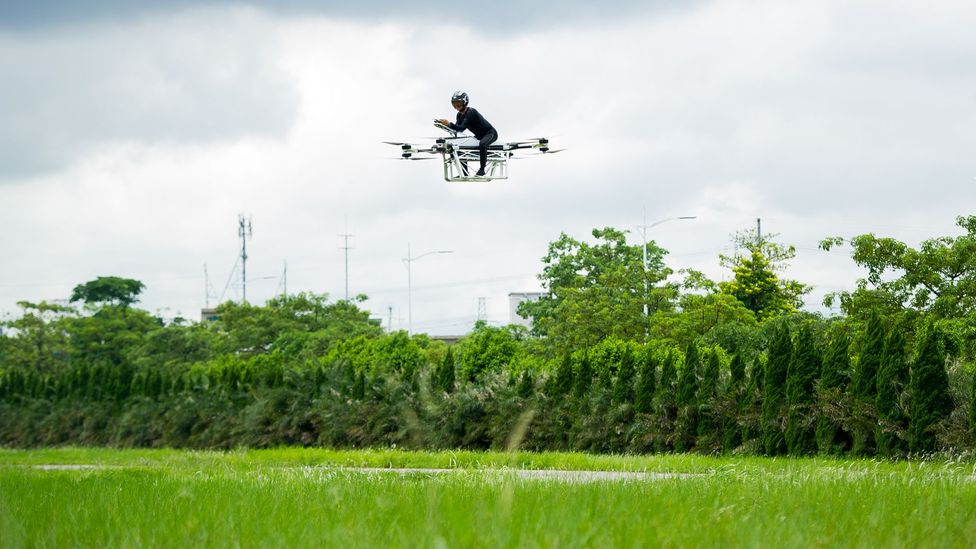
Zhao Deli rides a flying motorbike, which he built himself, during a test flight in 2019 in China (Credit: Getty Images)
Germany-based Volocopter, for instance, has marketed its VoloCity craft as the first commercially licensed electrically powered air taxi, a vehicle which will eventually run without a pilot. “It’s like an Uber Black or any other premium service,” says Fabien Nestmann, vice president of public affairs at Volocopter.
With a few key differences, that is. Initially, the VoloCity will only have room for a single passenger. That will mean a higher cost per ride at first, but Volocopter hopes to build consumer confidence before transitioning to a full-autonomy model: an electric, wingless craft powered by nine batteries, which will transport passengers throughout a planned network of vertiports – airports for planes that take off and land vertically – across major cities. VoloCity’s first commercial flights are scheduled to take place in 2022.
These first flights will cost €300 ($350/£270) per ticket. But eventually, says Nestmann, the company’s goal is to make the cost competitive with, say, an Uber Black. “We don’t want this to be a toy for the wealthy, but part of a well-integrated journey for anyone in an urban area,” he says. “Everyone should have the option to walk, be driven, cycle, or fly.”
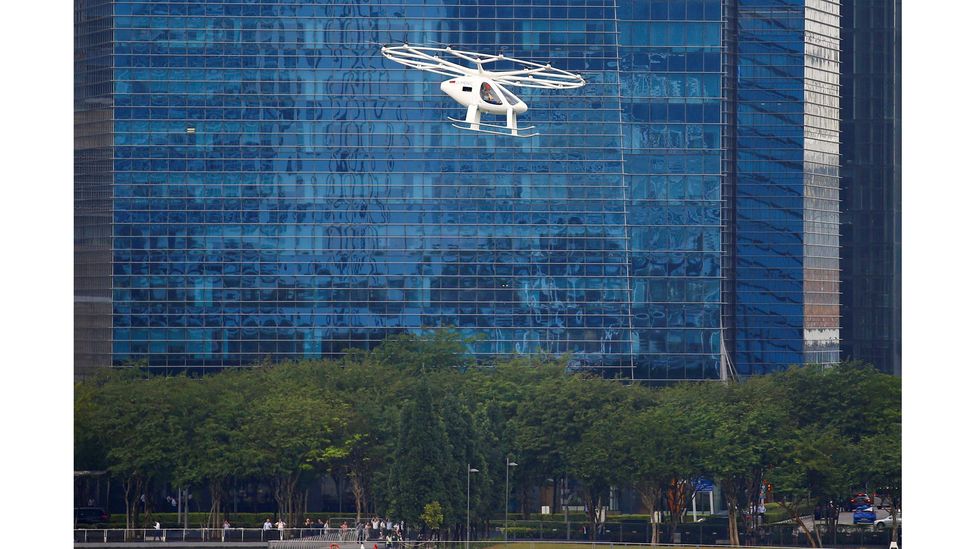
A Volocopter air taxi performs a demonstration in Singapore in October 2019 (Credit: Reuters)
Other companies have partnered with existing car manufacturers to create models they plan to develop for eventual commercial use. Japanese startup SkyDrive, for example, recently teamed up with Toyota to conduct a test flight of its all-electric air taxi, said to be the world’s smallest electric vehicle that can take off and land from a vertical position. This summer, the company successfully flew its SD-03 craft for several minutes around an airfield with a pilot at the helm.
“Consumer demand has grown, but humans have not yet provided a clear solution to traffic, even through options like electric cars or speedy alternatives like [France’s intercity] TGV train,” says SkyDrive representative Takako Wada. “You could say SkyDrive mobility has been nurtured by consumption demands as well as by advances in technology.”
Indeed, those advances makes it possible for so many aircraft designers to clamour for airtime, as it were. Companies like Lillium, Wisk, Joby Aviation, Bell and countless others are capitalising on innovations like electric propulsion, which dramatically reduces noise emissions, and battery power, which enhances range. For an industry in its infancy, there are no shortage of Vertical Take Off and Landing (VTOL) designs, or the imaginary heights that might be reached with them.
Consider Gravity Industries, a UK-based aeronautical company that created a 1,050-horsepower wearable jetpack. “It’s a bit like a Formula One car,” says Richard Browning, chief test pilot and founder of the company. “The Jetsuit is a specialist piece of equipment that only trade professionals and military fliers can ride, for now.” Browning gestures to a metallic, Batman-esque contraption in his studio. “Someday, the jetpack might mean a hovering super hero paramedic can make decisions about where to go and what to do.”

In September 2020, Richard Browning of Gravity Industries demonstrated the company’s flight pack in the Lake District (Credit: GravityIndustries/YouTube/PA Wire)
This is not as pie-in-the-sky a scheme as it sounds: the Great North Air Ambulance Service recently partnered with Gravity Industries to simulate a search and rescue mission. Browning flew in his jetpack from the craggy valley bottom of Langdale Pikes in England’s Lake District to a staged casualty site. By foot, it would have been a 25-minute arduous climb.
The flight took 90 seconds. The exercise illustrated the potential of jetpacks to deliver critical care services to remote locations.
“The dream of air transport has been around for a long time,” says Parimal Kopardekar, director of Nasa’s Aeronautics Research Institute at the Ames Research Center in Silicon Valley, California. “There’s a powerful opportunity now to design vehicles that can transport goods and services where current aviation can’t reach.”
Kopardekar is responsible for exploring aviation trends in autonomy and advanced air mobility, including VTOLs. Given the complexity of this undertaking, the team at Nasa must address and test an entire ecosystem of factors: aircraft, airspace, infrastructure, community integration, weather patterns, GPS, noise standards, maintenance, supply chain, parts acquisition… It’s a list that reveals numerous and not always obvious problems that must be resolved before aerial ridesharing at scale can become a reality.
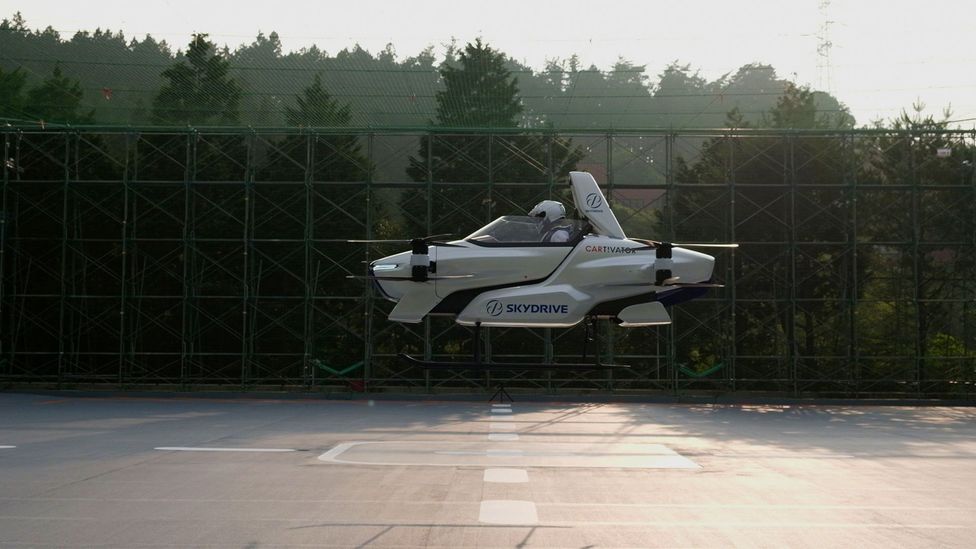
The SD-03, a manned flying car, takes a test flight in Japan in August 2020 (Credit: SkyDrive/Reuters)
Reimagining human flight requires vehicles that are “road legal” and safe to fly, but also a public willing to fly in them. Industry leaders need to convince riders that VTOLs aren’t compelling simply because the technology is possible, but because it is preferable to other modes of transport – and safe.
“You cannot offer commercial services without extremely vigorous testing regimes,” says Nestmann, who oversees Volocopter’s public education initiatives. “Part of that is developing the infrastructure for these machines.” That might mean hardware construction of vertiports and storage facilities equipped with electrical power, or software run behind the scenes: systems needed to run VTOLs will undoubtedly require near-full automation to properly coordinate the envisioned swarms of vehicles. While the commercial aircraft we travel on today are monitored by human controllers in a tower, the flying machines of tomorrow will rely on UTM: Unmanned Traffic Management. This digital tracking will ensure that all VTOLs have common awareness of other flights in their path.
Fully automated vertical transport with a proven track record may put the public at ease, but a vast network of flying objects creates a host of new challenges. VTOLs will obviate the need for runways or on-the-ground parking, but they will require dedicated air corridors and sky-harbours to store craft. Air taxis might reduce the number of cars on the ground and enhance arrival and departure time predictability, but the sheer number of objects in the sky – buildings, birds, delivery drones and airplanes – will require pilots (at least, while VTOLs are piloted) to practise a new kind of dynamic obstacle avoidance. The “Skyway”, for want of a better term, will need its own set of laws.
Additionally, manufacturers and operators will have to show that no harm will come either to passengers or to people on the ground below. In concert with the US’s Federal Aviation Administration and other regulatory bodies, Kopardekar and the team at Nasa created an “Urban Air Mobility Maturity Levels Scale”, which ranks craft, airspace and other systems on a scale of one to six based on complexity and urban density. They are devising ways to simplify cockpit operations, with a combination of automation and contingency management: guidelines for how a VTOL might respond to bad weather, bird strike, or sudden jetpack intruder, for example.
Already, incidents have shown the importance of these types of guidelines: in October 2020, crewmembers on a commercial airliner near LAX airport in Los Angeles spotted a jetpack at 6,000 feet (1,828m) – an altitude that presents serious risk of collision.
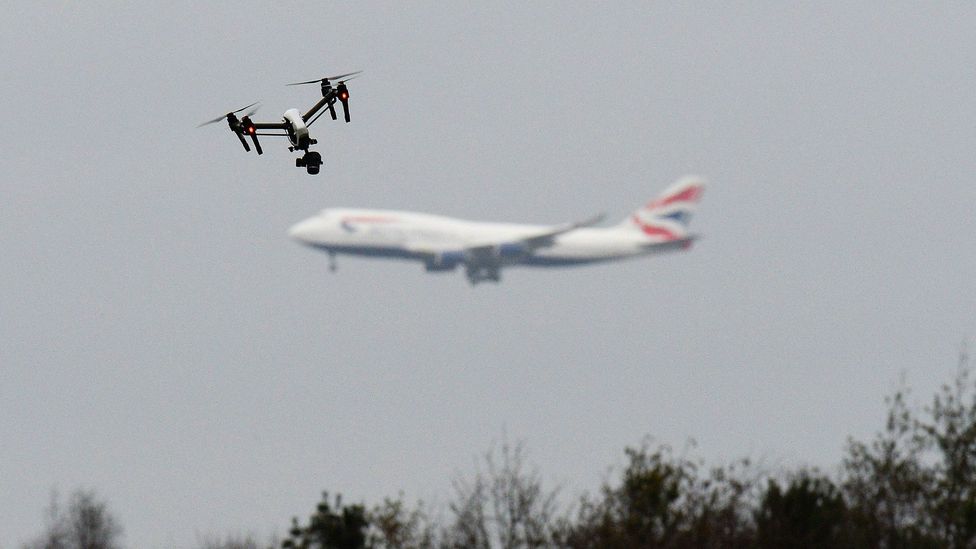
A drone flies in a west London park; as more flying objects are created, safety guidelines are becoming increasingly crucial (Credit: John Stillwell/PA Wire)
The European Aviation Safety Agency (EASA) has also created a set of technical specifications for VTOLS, though the agency hasn’t quite decided how to certify them. These specifications aim to address the unique characteristics of flying cars, and detail airworthiness standards like emergency exits, lightning protection, landing gear systems and pressurised cabins. “Despite having design characteristics of aeroplanes, rotorcraft or both,” EASA’s statement reads, “in most cases EASA was not able to classify these new vehicles as being either a conventional aeroplane or a rotorcraft.” In other words, EASA seems undecided about what, exactly, separates VTOLS from fixed-wing commercial jets or helicopters. Clearly, the successful operation of VTOLs will require coordinated efforts across sectors, including government, technology, transportation, urban planning and public outreach.
What accounts for the sudden proliferation of VTOL developers? Global trends like the rise of e-commerce, climate change, the gig economy and an integrated supply chain have accelerated interest in personal air travel, while failures in our current infrastructure and related industries underscore its necessity. As cities like New York, Hong Kong and Beijing reach capacity, urban living becomes less and less sustainable – yet our increasingly interconnected economy demands constant mobility.
The effects could transform commuting, and living, as we know it. “Right now, most people optimise living based on access to transportation,” notes Kopardekar. “VTOLs and drones will make it possible to reach people wherever they are, to optimise transportation based on living.” Businesses will no longer have to look to central business districts for their headquarters, while employees may choose to live anywhere within reach of an air taxi. Owning a VTOL could become as affordable and ubiquitous as owning a bicycle.
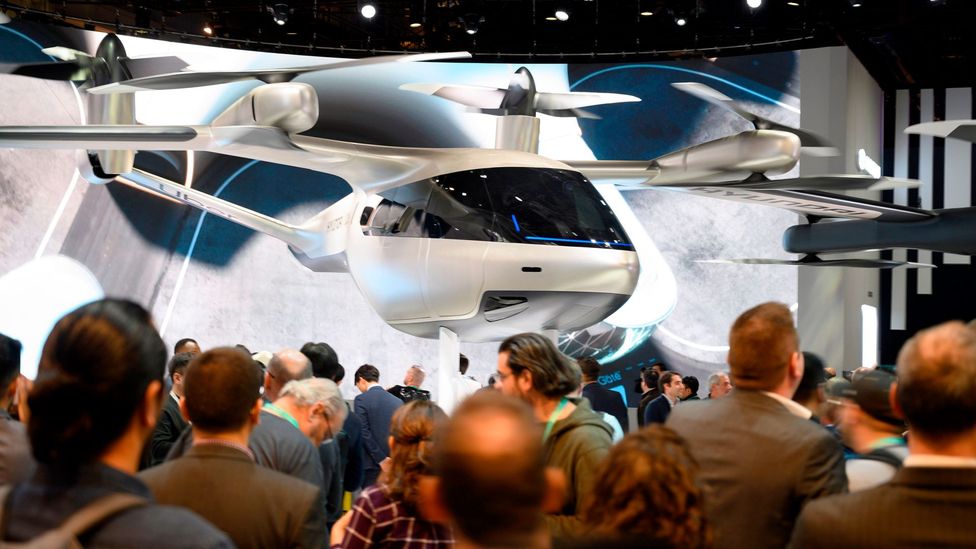
The Hyundai S-A1, which has been designed for Uber Elevate’s urban air travel service, is displayed in January 2020 (Credit: Robyn Beck/Getty)
“On the macro level, ever-growing cities create a growing mobility need from the citizens in those cities,” says Nestmann. “That leads to a rethinking of the city, because building everything around the car doesn’t improve life quality.” (and building everything around flying cars, drones and jet packs; having to totally restructure our infrastructure makes so much more sense? Right? NOT!)
Traffic bottlenecks wear down our cities’ highways and the cars we drive on them, contributing to emissions that in turn threaten our planet’s delicate ecosystems and our own health. Meanwhile, eVTOLS (which are electric) will dramatically reduce emissions or reliance on diesel fuel.
Increasing numbers of flying cars will naturally give rise to a changing layout in the way our cities are structured as cities grow taller, rooftop landings expand and air highways connect super sky-scrapers, freeing up space below. Fewer cars on the ground will reduce congestion and may give rise to parks and green spaces. (Ya, because all the green spaces in our national parks will be off limits to people. They have to find some place to put a few trees and a little grass to keep us humans pacified.) “In the long run – 2045 and onward – businesses and green spaces will become much more integrated,” says Kopardekar. “While we may not ever eliminate metros and roads, we might be able to reduce their footprint with these machines.” (replacing them with runways, landing strips, parking and maintenance.)
VTOLs have vast implications for the future of transport, work-life, consumption, urban design, even healthcare and ecology. As soon as 2030, consumers might be able to press a button and order an air taxi straight to their cloud-tethered office. In the decades that follow, we may ultimately have fewer and fewer reasons to descend to the earth below, conducting our business and our lives atop a city in the sky.
“One mile of road can only take you one mile,” says Kopardekar. “One mile of aviation can take you anywhere.”
—
Join one million Future fans by liking us on Facebook, or follow us on Twitter or Instagram.
If you liked this story, sign up for the weekly bbc.com features newsletter, called “The Essential List”. A handpicked selection of stories from BBC Future, Culture, Worklife, and Travel, delivered to your inbox every Friday.
spacer”’
Think about this: the innovations like the drones, flying cars and jet packs greatly increase their ability to surveil us. The more surveillance tools they have the easier it is to maintain complete control.
spacer

 Lucid Air
Lucid AirIt is a guarantee that all of these new developments are for the use and the pleasure of the ELITE and not the general public. I would venture to say that the Ruling Elite already own and use most of this stuff and even more that we have not ever been privy to.
StrangeSounds.org has been banned from ad networks and is now entirely reader-supported CLICK HERE TO SUPPORT MY WORK… Thanks in advance!
SPACER
The globalists at the World Economic Forum (WEF) are calling for an end to private vehicle ownership in favor of public transportation and “communal” cars.
“The average car or van in England is driven just 4% of the time,” said Winnie Yeh, who is described as WEF’s “lead” for “responsible sourcing.” Klaus Schwab is the founder and executive chairman of the WEF.
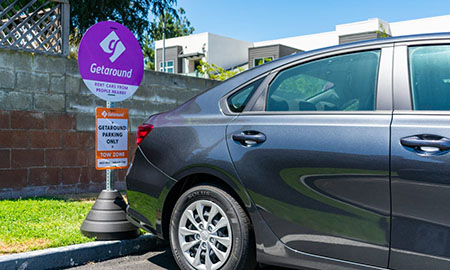
Yeh then calls on car owners to sell their vehicle because, “car sharing platforms such as Getaround and BlueSG have already seized that opportunity to offer vehicles where you pay per hour used.”
“More sharing can reduce ownership of idle equipment and thus material usage,” Yeh wrote in an article published on WEF’s website. All of this, Yeh said, is “part of broader transition from ownership to usership.”
A number of European nations and U.S. states have already passed legislation that will ban the sale of non-electric cars as soon as 2030. Washington, New York and California have already passed such measures as have a number of EU member states.
In Ireland, the government has told citizens that they will be packed into densely populated cities in order to combat climate change. Drivers will be forced off the roads as part of a plan that will “revolutionize” people’s lifestyle and behaviors.
The International Energy Agency (IEA) has directed global governments to drastically cut oil supply to domestic consumers in order to encourage compliance by “nudging” people out of their private cars.
The IEA 10-point plan to drive “changes in the behavior of consumers” and reduce gas demand at the pump includes reducing speed limits, working from home three days a week, more electric cars, car-free Sundays, more cycle lanes, cheaper public transport and greater use of long-distance trains over planes, Breitbart News reported.
Related: Who is Klaus Schwab? The ‘Great Reset’ is no conspiracy theory, January 12, 2022
In order to avert a “climate apocalypse”, governments plan to force people “out of private cars because they are the biggest offenders for emissions” with proposals that include banning fossil fuel vehicles from towns and cities intentionally cripple ordinary motorists.
Ending private car ownership is essential to addressing climate change, the WEF argues. The forum goes on to advocate for the same principles to be applied to city and home designs as well.
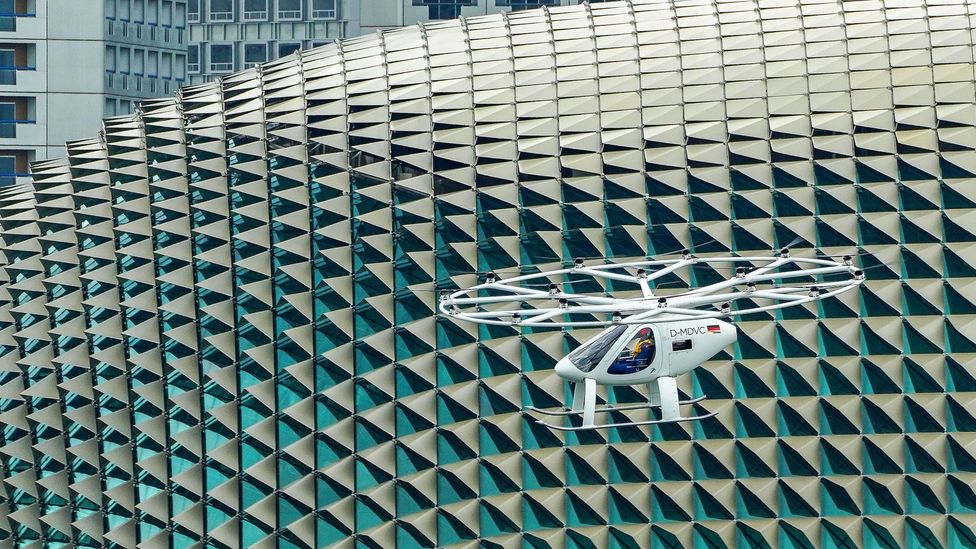

Comments are closed.